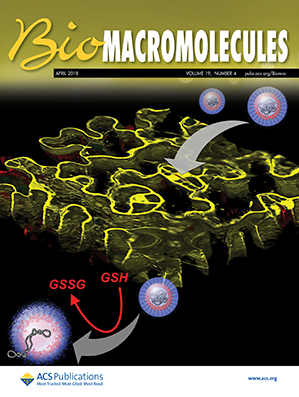Coarse-Grain Model of Ultrarigid Polymer Rods Comprising Bifunctionally Linked Peptide Bundlemers
IF 5.5
2区 化学
Q1 BIOCHEMISTRY & MOLECULAR BIOLOGY
引用次数: 0
Abstract
Computationally designed homotetrameric helical peptide bundles have been functionalized at their N-termini to achieve supramolecular polymers, wherein individual bundles (“bundlemers”) are the monomeric units. Adjacent bundles are linked via two covalent cross-links. The polymers exhibit a range of conformational properties, including formation of rigid-rods with micrometer-scale persistence lengths. Herein, a coarse-grained model is used to illuminate how molecular features affect the rod-like behavior of the polymers. With increasing affinity between bundlemer ends, a sharp transition in the persistence length is observed. Doubly linked chains exhibit larger persistence lengths and more robust formation of rigid-rod structures than singly linked chains. Chain stiffness increases with decreasing temperatures. Increasing the length of the cross-linker results in more flexible chains. This model provides insights into how molecular features control the structural properties of chains comprising doubly linked rigid bundlemers.
- Download: Download high-res image (117KB)
- Download: Download full-size image
包含双功能连接肽束的超硬聚合物棒的粗粒模型。
通过计算设计的同四聚体螺旋肽束在其 N 端被功能化,从而形成超分子聚合物,其中单个肽束("bundlemers")是单体单元。相邻的肽束通过两个共价交联连接在一起。聚合物表现出一系列构象特性,包括形成具有微米级持续长度的刚性杆。本文使用粗粒度模型来阐明分子特征如何影响聚合物的杆状行为。随着束聚合物末端之间亲和力的增加,可以观察到持久长度的急剧变化。与单链相比,双链表现出更大的持续长度和更强的刚性杆状结构形成能力。链的硬度随着温度的降低而增加。增加交联剂的长度会使链更柔韧。该模型有助于深入了解分子特征如何控制由双链刚性束膜组成的链的结构特性。
本文章由计算机程序翻译,如有差异,请以英文原文为准。
求助全文
约1分钟内获得全文
求助全文
来源期刊

Biomacromolecules
化学-高分子科学
CiteScore
10.60
自引率
4.80%
发文量
417
审稿时长
1.6 months
期刊介绍:
Biomacromolecules is a leading forum for the dissemination of cutting-edge research at the interface of polymer science and biology. Submissions to Biomacromolecules should contain strong elements of innovation in terms of macromolecular design, synthesis and characterization, or in the application of polymer materials to biology and medicine.
Topics covered by Biomacromolecules include, but are not exclusively limited to: sustainable polymers, polymers based on natural and renewable resources, degradable polymers, polymer conjugates, polymeric drugs, polymers in biocatalysis, biomacromolecular assembly, biomimetic polymers, polymer-biomineral hybrids, biomimetic-polymer processing, polymer recycling, bioactive polymer surfaces, original polymer design for biomedical applications such as immunotherapy, drug delivery, gene delivery, antimicrobial applications, diagnostic imaging and biosensing, polymers in tissue engineering and regenerative medicine, polymeric scaffolds and hydrogels for cell culture and delivery.
 求助内容:
求助内容: 应助结果提醒方式:
应助结果提醒方式:


